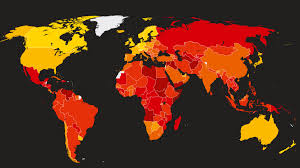2024: Denmark Leads Top 10 Least Corrupt Countries

Did you know that while Denmark tops the list of least corrupt countries in the world, South Sudan, Somalia and Venezuela are the most corrupt, according to the Corruption Perceptions Index?
The Corruption Perceptions Index (CPI) assesses countries by their perceived levels of public sector corruption, as assessed by experts and business executives. The CPI generally defines corruption as an "abuse of entrusted power for private gain".
The index is published annually by the non-governmental organisation, Transparency International (TI) since 1995, a German registered association founded in 1993 by former employees of the World Bank. Based in Berlin, its nonprofit and non-governmental purpose is to take action to combat global corruption with civil societal anti-corruption measures and to prevent criminal activities arising from corruption. Its most notable publications include the Global Corruption Barometer and the Corruption Perceptions Index (CPI).
The 2024 CPI, published in February 2025, currently ranks 180 countries "on a scale from 100 (very clean) to 0 (highly corrupt)" based on the situation between 1 May 2023 and 30 April 2024.
Denmark, Finland, Singapore, New Zealand, Norway, Switzerland and Sweden, (all scoring above 80 over the last five years), are perceived as the least corrupt nations in the world — ranking consistently high among international financial transparency — while the most apparently corrupt is South Sudan (scoring 8), along with Somalia (9) and Venezuela (10).
The advanced economies of Northern and Western Europe, North America, and Asia and the Pacific tend to top the rankings over the long term. This means that these countries are perceived as having a low level of corruption in the public sector. These nations also generally have well-functioning judicial systems, a strong rule of law, and political stability – all factors that contribute to perceptions of clean governance.
However, while these top-ranked countries have strong domestic institutions, their commitment to fighting corruption appears to be weak when it comes to their own financial systems and regulations affecting the international environment. The CPI doesn't capture transnational corruption, so corrupt foreign business practices by companies from these countries don't affect their CPI scores. The example of the Netherlands highlights this issue. Despite a high CPI score, the Netherlands has a poor record of prosecuting companies that bribe foreign officials to win contracts, as seen in the Nigerian oil bribery case.
Here are the 2024 rankings in the order of Country, Score and Rank:
TOP 10: LEAST CORRUPT COUNTRIES
1. Denmark, 90, 1st
2. Finland, 88, 2nd
3. Singapore, 84, 3rd
4. New Zealand, 83, 4th
5. Luxembourg, 81, 5th
6. Norway, 81, 5th
7. Switzerland, 81, 5th
8. Sweden, 80, 8th
9. Netherlands, 78, 9th
10. Australia 77, 10th
TOP 10: MOST CORRUPT COUNTRIES
1. South Sudan, 8, 180th
2. Somalia, 9, 179th
3. Venezuela 10, 178th
4. Syria, 12, 177th
5. Yemen 13, 173rd
6. Eritre 13, 173rd
6. Libya 13, 173rd
7. Equatorial Guinea, 13, 173rd
8. Nicaragua, 14, 172nd
9. Sudan, 15, 170th
10. North Korea, 15, 170th
Although the CPI is currently the most widely used indicator of corruption globally, it is worth emphasizing that there are some limitations. First, the CPI does not distinguish between individual types of corruption (some are not even included in the index) and people's perceptions do not necessarily correspond to the actual level of corruption. To get a more comprehensive picture, the CPI should be used alongside other assessments. Furthermore, the CPI is better suited for analyzing long-term trends, as perceptions tend to change slowly.
SOURCES: Wikipedia | Transparency International
#penglobalfactfile #CPI #corruption


_1755775186.jpg)
